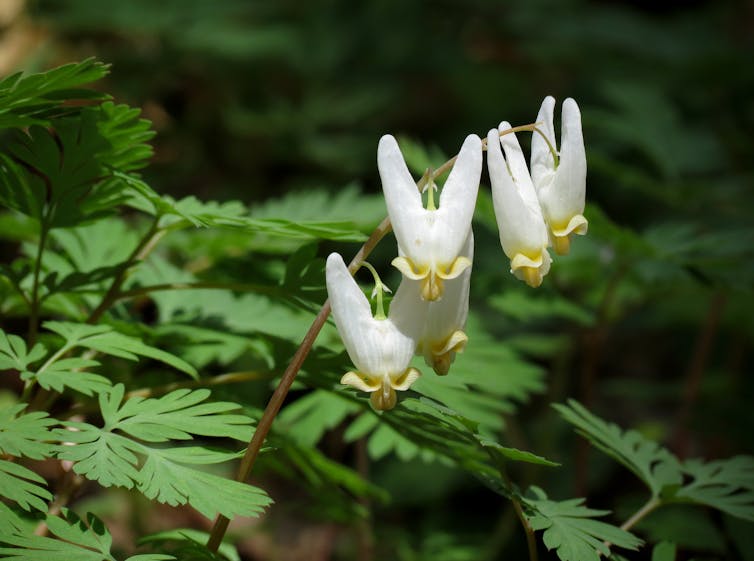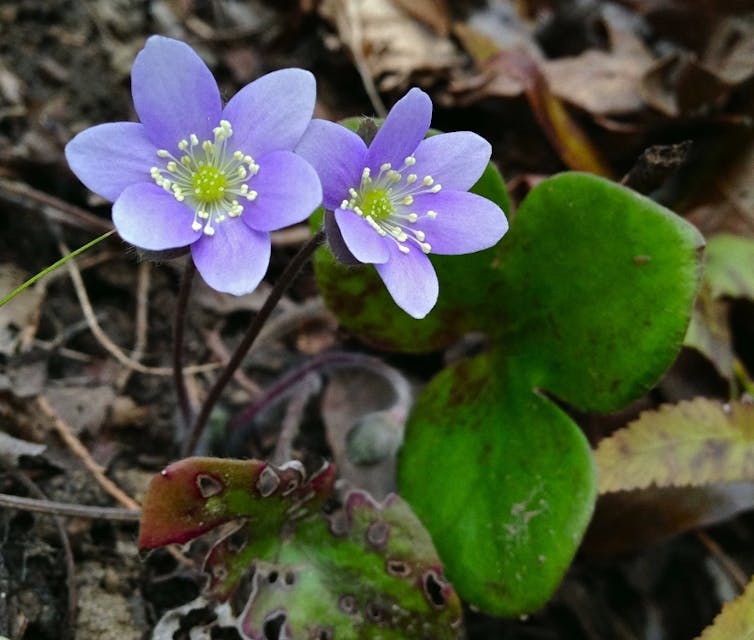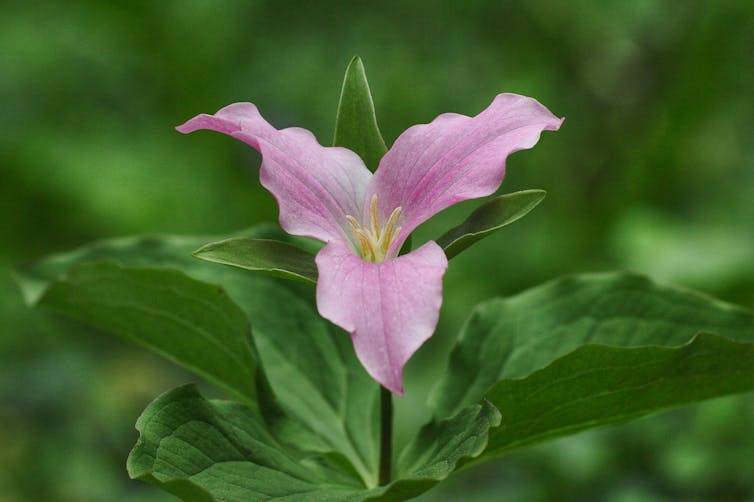Climate change threatens spring wildflowers by speeding up the time when trees leaf out above them.
 For short-lived spring wildflowers such as wood anemone (Anemone quinquefolia) and Dutchman’s breeches (Dicentra cucullaria), timing is everything. These fleeting plants, known as ephemerals, grow in temperate forests around the world, leafing out and flowering early in spring before the trees towering above them leaf out. Emerge too early, and it will still be winter; emerge too late, and it will be too shady under the forest canopy for essential photosynthesis to happen.
For short-lived spring wildflowers such as wood anemone (Anemone quinquefolia) and Dutchman’s breeches (Dicentra cucullaria), timing is everything. These fleeting plants, known as ephemerals, grow in temperate forests around the world, leafing out and flowering early in spring before the trees towering above them leaf out. Emerge too early, and it will still be winter; emerge too late, and it will be too shady under the forest canopy for essential photosynthesis to happen.

Over their evolutionary history, these plants have figured out the best timing for their survival. But climate change is altering spring growing conditions, and plant life is changing along with it.
 There are many examples of plants shifting flowering time in response to warming temperatures, such as cherry blossoms opening earlier and earlier each year. However, when one part of an ecosystem shifts, will all the organisms that depend on it successfully shift too? Or will they be out of luck? And what if interconnected species respond to change at different rates, leading to disruptions in long-standing ecological relationships?
There are many examples of plants shifting flowering time in response to warming temperatures, such as cherry blossoms opening earlier and earlier each year. However, when one part of an ecosystem shifts, will all the organisms that depend on it successfully shift too? Or will they be out of luck? And what if interconnected species respond to change at different rates, leading to disruptions in long-standing ecological relationships?
Researchers have been asking these types of questions about phenology – the timing of biological events – related to climate change for years. But most studies have focused on plant-animal interactions, like pollinators coming out at the wrong time for flowers. Far fewer have analyzed plant-plant interactions, such as spring ephemerals that need time to grow before trees leaf out above them and block the sunlight.
Our research group has investigated the mismatch between understory wildflowers and canopy trees around Concord, Massachusetts, using historical observations recorded by Henry David Thoreau, the author of “Walden,” his classic account of life in the woods. We found that trees in Concord were more sensitive to spring temperatures than wildflowers were, and that this resulted in earlier tree leaf-out that reduced available light in the understory.
This finding was an important first step, but we wanted to know whether these patterns persisted in other temperate forests in North America and across the Northern Hemisphere. Our latest study shows that the answer is yes.

 North American mismatches
North American mismatches
For this research we used specimens from herbariums – collections of plants that have been pressed, dried and cataloged. The plants we examined were collected across eastern North America over the past 100 years. We evaluated over 3,000 pressed plant specimens to chart leafing-out time for trees and flowering time for spring wildflowers.
The vast scale of this study was made possible because herbaria have digitized millions of photographs of plant specimens and made them available online over the past decade. Before this resource existed, researchers had to travel to many museums scattered around the country.
Historical weather records are also available online now. This allows researchers to determine spring temperatures for the year and place where each specimen was collected.
Our new study enabled us to confirm the results of our work in Concord. We found that as temperatures warm, deciduous trees across eastern north America are advancing their leaf-out timing faster than native wildflowers are responding.
 For example, during cooler springs with 24-hour average March and April temperatures of 41 degrees Fahrenheit (5 degrees Celsius), trees leafed out 13 days after native wildflowers. This gave the flowers almost two weeks of full sun on the forest floor. However, during warmer springs, with average temperatures of 58 F (15 C), trees leafed out only 10 days after native wildflowers. This gave the wildflowers about 25% less full sunlight time during which to photosynthesize.
For example, during cooler springs with 24-hour average March and April temperatures of 41 degrees Fahrenheit (5 degrees Celsius), trees leafed out 13 days after native wildflowers. This gave the flowers almost two weeks of full sun on the forest floor. However, during warmer springs, with average temperatures of 58 F (15 C), trees leafed out only 10 days after native wildflowers. This gave the wildflowers about 25% less full sunlight time during which to photosynthesize.
As spring temperatures warm even further with climate change, we expect wildflowers will have even shorter periods of full sunlight. This can mean a sizable decrease in the flowers’ energy supply and ability to survive, grow and reproduce.

We also observed that trees and wildflowers in the warmer southern part of their ranges advanced their leaf-out and flowering times faster, respectively, than those in colder northern locations. In these zones, we found greater timing differences between trees and wildflowers. This means the potential for phenological mismatch, where native wildflowers are more likely to be shaded out by trees, is greater in the southeast U.S. than in areas farther north.
 Parallels and differences on other continents
Parallels and differences on other continents
For another recent study, we collaborated with colleagues from China and Germany to evaluate over 5,000 tree and wildflower specimens collected over the past 120 years. We wanted to see to whether the phenological mismatches that we documented in North America could also be found in temperate forests of East Asia and central Europe.
Our team found a common pattern across all three continents. Trees and wildflowers are active earlier now than in the past, and they are active earlier in warm years and places.
However, in a surprising twist, we didn’t see the North American pattern of trees being more sensitive than wildflowers on the other two continents. In Europe, wildflowers and canopy trees seemed to be shifting together over time. In Asia, the understory wildflowers were shifting more than the trees — meaning they might get more light, not less, in a warmer future.
The differences we found among the three regions were due primarily to variation in the sensitivities of the trees to temperature. Trees in eastern North America responded more strongly to temperature shifts, while Asian trees responded less strongly.
These results suggest that eastern North American trees have become especially sensitive to temperature as a way of adapting to this region’s highly variable climate. In contrast, trees in East Asia are apparently more sensitive to other environmental cues, such as day length, when it comes to the timing of spring growth.
 Informing forest management
Informing forest management
Our results pose questions for further research. If spring temperatures aren’t the primary cues determining leaf-out and flowering times of trees and wildflowers in East Asia, what are those cues? How does the declining spring light window for wildflowers in eastern North America affect their energy budgets and ability to survive, grow and flower?
Another question is whether there are any practical management techniques, such as thinning overstory trees or removing invasive plants, that can help wildflowers deal with the ongoing challenges of climate change. Such strategies could help people appreciate and conserve the full range of plants in the forests we depend on and cherish around the world.![]()
Richard B. Primack, Boston University; Benjamin R. Lee, University of Pittsburgh, and Tara K. Miller, Boston University
Richard B. Primack, Professor of Biology, Boston University; Benjamin R. Lee, Postdoctoral Fellow in Biology, University of Pittsburgh, and Tara K. Miller, PhD Candidate in Biology, Boston University
This article is republished from The Conversation under a Creative Commons license. Read the original article.